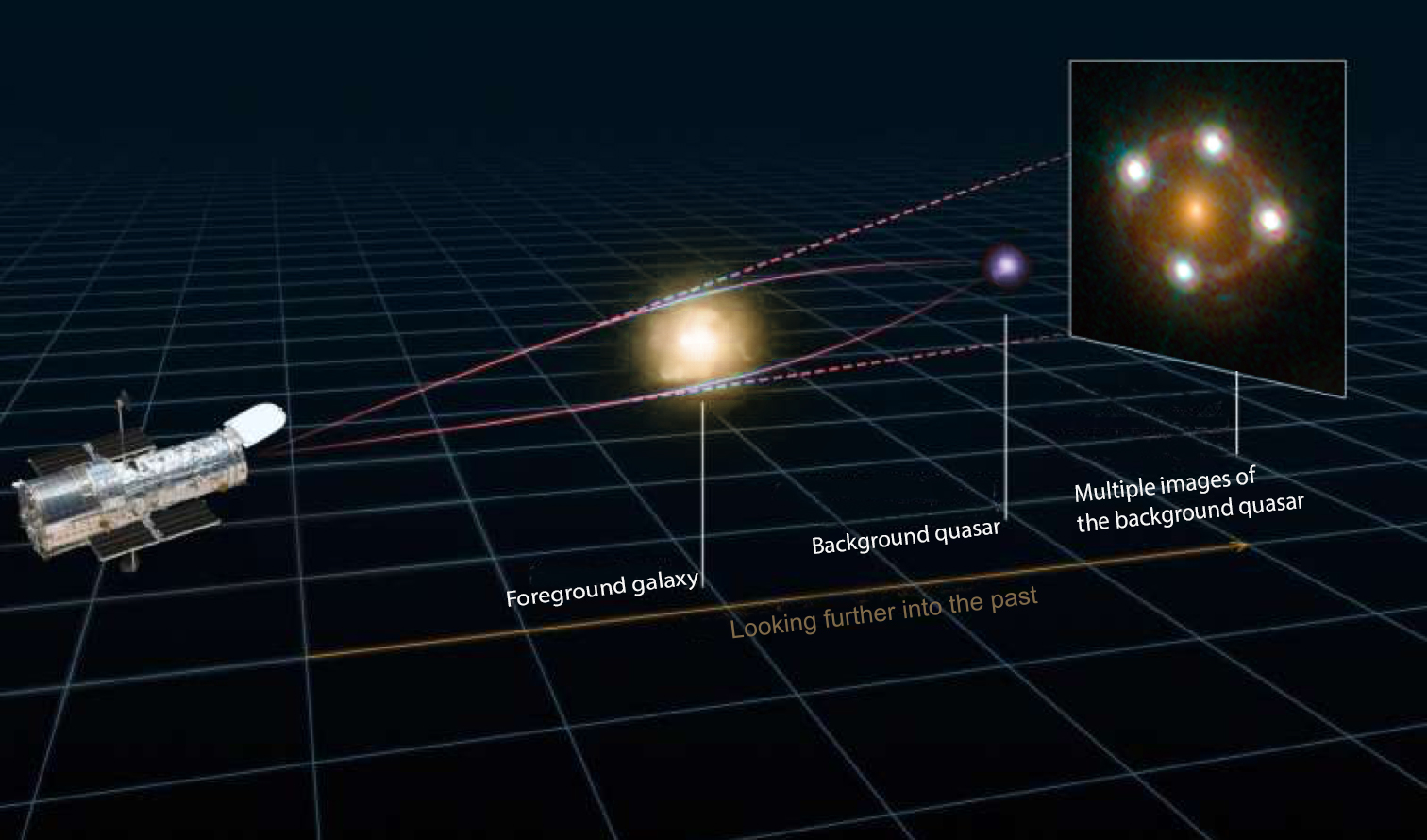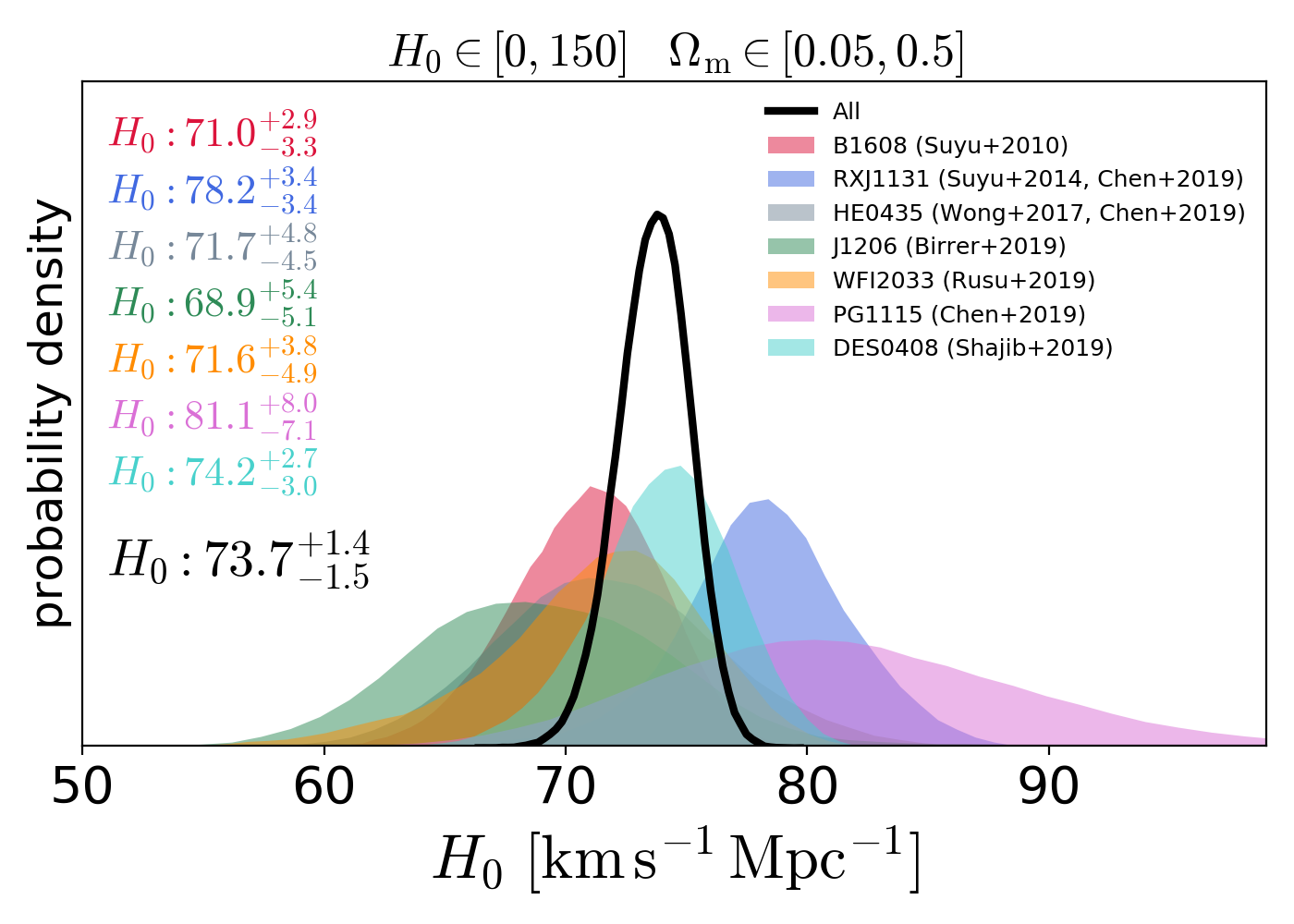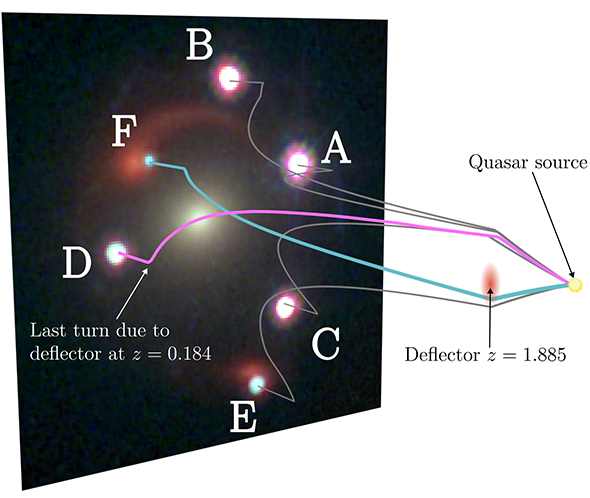Research
Time-delay Cosmography & the Hubble Constant
Gravitational lensing sometimes produces multiple

As the path taken by photons in the different images can be a bit shorter or a bit longer, they reach the observer at different time. In the video below, you can see the variation of the lensed quasar WFI2033-4723 over more than 15 years. The same luminosity variations arrive in the different multiple images, but delayed in time. By shifting the light curves, we can measure the time delay, which is inversely proportional to the Hubble Constant.
- A measurement of the time delays. This can be obtained from long-term monitoring of the lensed quasars with small telescopes
- The distribution of the mass of the lensing galaxy, that can be reconstructed from high-resolution images
- An estimate of the external convergence, i.e. the matter density along the line of sight
- An estimate of the stellar velocity dispersions of the lensing galaxy, which provide a second estimate of its mass.
Combining these four ingredients, we have recently measured H0 = 73.7+1.4-1.5 km.s-1.Mpc-1, using 7 gravitationally lensed quasars. This is in good agreement with the distance ladder method, using pulsating stars and Supernovae Ia, but in tension with the CMB measurement of Planck.

Using weaker assumptions on the mass profile of the lens galaxy but better stellar kinematic data, we found H0 = 71.6+3.9-3.3 km.s-1.Mpc-1, with the 8 time-delay lenses. We are currently gathering more and more stellar kinematic observations to keep improving the precision of our measurement.
In october 2024, we discovered the first Einstein zig-zag lens , where the light from the background quasar is deflected by two different galaxies at different redshift. The optical path taken by the photons is is forming a zig-zag between the two deflecting galaxies as illustrated below. We are currently working on the analysis of this system and expect to release the results soon.

Selected publications
- Millon, Galan, Courbin et al. (2020a), A&A, 639, A101.
- Wong, Suyu, Chen, Rusu, Millon et al. (2020), MNRAS, 498, 1-1420.
- Millon, Courbin, Bonvin et al. (2020b), A&A, 642, A193.
- Millon, Courbin, Bonvin et al. (2020c), A&A, 640, A105.
- Dalang, Millon, and Baker (2023), PRD, 107, 12.
- Birrer, Millon, Sluse et al. (2022), Space Science Reviews, 220, 5, 48 (review article).
- Dux, Millon, Lemon et al. (2024), A&A, 694, A300 (Einstein zig-zag lens).
- TDCOSMO Collaboration et al. (2025), arXiv:2506.03023 (TDCOSMO 2025 cosmological results).
Black holes and accretion disks
Microlensing is a unique tool to probe the structure of accretion disk around Supermassive Black Holes. Microlensing occurs in strongly lensed quasar when a star passes in front of one of the quasar's multiple images. The star itself is not sufficiently massive to produce detectable lensed images but it slightly changes the apparent brightnest of the quasar. As the alignment between the star and the quasar change over time, the magnification of the quasar image varies. And there is a remarkable coincidence : the caustics produced by the star has a similar size (a few nano-arcsecond) than the angular size of an accretion disk seen at cosmological distances. This coincidence makes this technique sensitive to structures that have the size of the solar system in galaxy located at several billion of light years, which far beyond the resolution power of the biggest telescope !
We have used the microlensing signal to measure the size of the accretion disk (e.g. this paper ). In the future, multiband observation of the Rubin observatory will also inform us about the temperature profile of accretion disks with this technique.
Recently, we have found unexpected periodic variations in the microlensing signal of lensed quasar J0158-4325, with a period of 172.6 days. This signal is only observed in the flux ratios of this lensed quasars, i.e. once the time delay is corrected and the intrinsic variations of the quasar are subtracted. The periodicity of this signal is best explained in the context of Supermassive Binary Black Hole. The animation below shows how the gradient of magnification produced by the microlense leaves a detectable periodic signal in the microlensing light curves.
Selected publications
- Millon, Dalang, Lemon et al. (2022), A&A, 668, A77.
- Chan, Rojas, Millon et al. (2021), A&A, 647, A115.
- Chan, Millon, Bonvin et al. (2020), A&A, 636, A52.
- Cornachione, Morgan, Millon, et al. (2020), ApJ, 895, 2, 125.
Galaxies and Quasars co-evolution
In the local Universe, we observe that there is a correlation between the galaxies' mass and the mass of their central supermassive black hole. This is often interpreted as a sign of their co-evolution. In the standard scenario of galaxy formation, the central quasar, a.k.a. the AGN, controls the growth of its host galaxy through a mechanism called “AGN feedback” : the energy radiated by the quasar is injected into the galaxy and regulates its growth, which leads to a tight correlation of their masses. By studying this correlation (and its evolution across cosmic time), we can test galaxy evolution scenarios, confront them to the observations and, finally, understand how galaxies form and grow. But this means that we need robust mass estimates in the distant Universe, where standard techniques are both imprecise and subject to biases.

Selected publications
- Millon, Courbin, Galan et al. (2023), Nature Astronomy, 7, 959-966.
- MacArthur, Millon, Powell et al. (2025), arXiv:2511.02009
Image processing and deconvolution
The images captured by ground-based telescopes often suffer from blurring caused by turbulence in the Earth's atmosphere. But this can be corrected, provided that we can measure the Point Spread Function (PSF), which describes the blurring effect. It is however a complex and challenging "ill-posed" mathematical problem due to the presence of noise and pixelation in the data. To solve this long-standing "deconvolution" problem, we have introduced a novel solution called STARRED. This method is based on three main principles :
- the image is reconstructed in two separate channels: one for the point sources and one for the extended sources
- the code relies on the deliberate choice of not completely removing the effect of the PSF, but rather bringing the image to a higher resolution with a known Gaussian PSF.
- we use starlet to regularise the deconvolution problem
